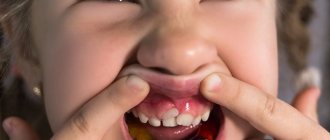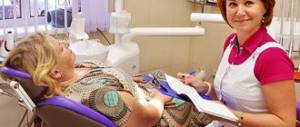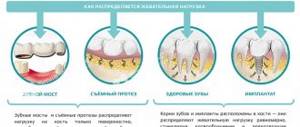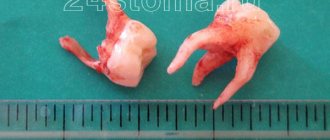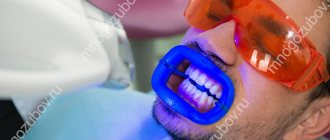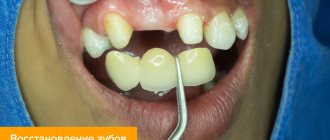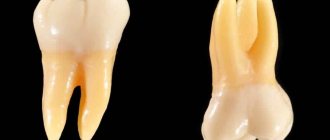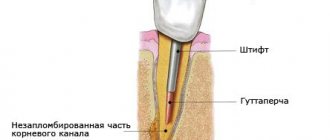Supernumerary teeth - what are they?
Supernumerary teeth (hyperdontia) are “extra” teeth. This anomaly occurs quite often: 5% of people have more than 32 teeth. Moreover, in 70% of cases one supernumerary tooth grows, in 25% of hyperdontia - 2 teeth, and only 5% of people - 3 or more. In women and men, this anomaly occurs with the same frequency.
Hyperdontia is not an individual human norm. This is a disease that has its own coding according to ICD 10. It corresponds to the alphanumeric code K00.1.
Kinds
Supernumerary teeth can be located:
- in the dentition with a change in the correct position of normal dental elements;
- in atypical places (dystopic teeth), for example, on the palate or on the front surface of the gums;
- in the bone tissue of the jaw and do not erupt into the oral cavity (impacted).
Photo: supernumerary teeth of the lower jaw
Depending on the shape of the crown, supernumerary teeth can be of several types:
- lumpy;
- spiny;
- chisel-shaped;
- pineal;
- split;
- fused.
Types of polyodontia
Supernumerary teeth can develop in a variety of ways. Therefore, they are usually classified into several groups depending on their characteristics. By origin, polyodontia can be false or true.
The false variety is manifested in the fact that baby teeth do not fall out, they are firmly fixed in the bite. This anomaly occurs due to the fact that adjacent bone processes grow together.
True form - grow due to genetic predisposition and negative influence on the formation of teeth during the prenatal period. The patient experiences the eruption of additional unnecessary tooth germs.
Depending on the location, the anomaly can be typical or atypical. In the first case, the supernumerary teeth are located in the main row. The atypical form is manifested in the fact that bone processes are formed outside the row.
Reasons for appearance
Medicine does not give an exact answer why the program fails in the human body and supernumerary teeth appear.
Hypotheses explaining the etiology of the phenomenon:
- Atavism hypothesis . Supernumerary teeth are a return to the original number of dental elements, which was normal for human ancestors (it is believed that they had 6 incisors on the upper and lower jaws).
- Theory of splitting of the tooth germ . Hyperdontia is a consequence of impaired activity of the dental plate during embryonic development, as a result of which a significantly larger number of dental buds are formed from it. The hypothesis is supported by the increase in recent decades in the number of cases of the appearance of extra teeth as a result of the influence of unfavorable environmental conditions, thyroid diseases and other negative factors.
Symptoms
The main symptom characteristic of hyperdontia is the presence of extra teeth in the oral cavity, which often interfere with talking, eating, and also spoil a person’s appearance. However, in children and adults, supernumerary teeth can also have slightly different clinical manifestations, which will be discussed below.
Symptoms in children
Supernumerary baby teeth appear in a child before birth or in the first months of life. In this case, the main symptoms are associated with difficulties in breastfeeding: it becomes more difficult for the baby to latch onto the nipple and suck milk. He begins to be capricious and refuse to breastfeed. The skin on the mother's chest is injured with the formation of deep and inflamed cracks.
Photo: supernumerary tooth in a child
Symptoms of hyperdontia of primary teeth in older children are similar to symptoms of the eruption of normal dental elements, which may be accompanied by:
- moderate increase in temperature;
- soreness of the mucous membrane and swelling in the area of the growing tooth;
- excessive salivation;
- swelling of the nasal mucosa with difficulty in nasal breathing;
- loosening of the stool.
Symptoms are especially severe when teeth erupt in the area of the upper palate.
At 2 years of age, hyperdontia negatively affects the development of speech in a child. It becomes difficult for children to pronounce individual sounds and this cannot be corrected by speech therapy techniques. In addition, injury to the tongue or mucous membranes often occurs, which leads to chronic inflammatory diseases in the oral cavity.
In school-age children, an increase in the number of teeth often becomes the cause of ridicule from peers, the development of complexes and disruption of social adaptation.
Symptoms in adults
Hyperdontia in permanent teeth is more common than in primary teeth.
Dystopic supernumerary teeth
Dystopic supernumerary teeth are additional teeth outside the normal dental arch. They erupt in the palate and on the lingual surface of the gums.
The clinic is caused by the presence of excess dental elements in the oral cavity:
- sound pronunciation disorders;
- changes in the normal position of teeth up to their dystopia: rotation around their axis, curvature of the growth angle;
- severe malocclusion;
- injury to the mucous membranes with the development of inflammatory diseases in the oral cavity;
- Often the presence of hyperdontia leads to disturbances in chewing function and chronic digestive problems.
Dystopic supernumerary teeth can cause psychological problems: poor smile aesthetics makes a person withdrawn and uncommunicative. Psychological problems provoke symptoms of chronic diseases of the nervous, digestive, endocrine and other systems - in medicine the phenomenon is called psychosomatics.
Impacted supernumerary teeth
Impacted supernumerary teeth do not erupt into the oral cavity and remain in the bone tissue of the jaw. Often they do not manifest themselves until complications develop, and in most cases they are discovered accidentally during examination.
Symptoms:
- pathological loosening of normal teeth;
- bulging of the bone (when the impacted tooth is close to the edge of the jaw);
- periodically occurring aching pain over the area of occurrence.
With the development of complications (formation of cysts, osteomyelitis of the jaw), the symptoms will be characteristic of the resulting pathological condition.
One of the most difficult situations in dentistry is the combination of supernumerary teeth and impacted third molars (“wisdom teeth”). At the same time, excess dental elements can take up free space in the dentition, but unerupted “eights” have a negative impact on the root system of the remaining teeth and can cause serious complications
Impacted tooth
Diagnostics
Identifying erupted supernumerary teeth is not difficult. Often, patients themselves, already at the initial examination, complain that they have a tooth that should not be there.
The situation is more complicated with hyperdontia with impaired eruption . In such cases, the main diagnostic method is x-ray (panoramic radiography). It allows you to clearly visualize all dental elements, both normal and supernumerary, as well as their location. The disadvantage of the technique is that the X-ray image is flat and cannot be used to characterize the exact relative position of all teeth and their root systems. Therefore, patients often undergo additional computed tomography .
Diagnosis of microdentia
According to statistics, about 5% of people face the problem of microdentia – abnormally small teeth in an adult. There are several signs that allow you to distinguish microdentia from other dental pathologies.
Symptoms of microdentia
- teeth of regular shape, but with a significantly reduced crown;
- distances between teeth visible to the naked eye;
- damage mainly to the front teeth;
- wavy or jagged shape of the cutting part of the affected tooth.
In most cases, the presence of microdentia can be determined by visual examination of the patient, but for a more accurate diagnosis, hardware diagnostics are performed. For example, the doctor can measure the overall width of the incisors of both jaws using a special instrument, as well as resort to x-rays. A deviation is considered to be a reduction of teeth by 1.5 mm or more relative to the norm. Based on the results of the examination, one of three types of microdentia is determined.
Isolated
If the patient has one or two small teeth, then we are talking about isolated microdentia. Most often, the front incisors (mainly the lateral incisors) are underdeveloped.
Relative
Relative microdentia is said to occur when the patient has an abnormally enlarged jaw. On such a jaw, even normal-sized crowns can look disproportionately small. Thus, relative microdentia is an overly large gum and small teeth on it.
Generalized
In the most severe cases, when small teeth are located throughout the jaw, the patient is diagnosed with “generalized microdentia.”
Treatment
Therapeutic measures for hyperdontia:
- relieving symptoms of eruption of supernumerary teeth, which are especially relevant for children;
- removal of supernumerary teeth;
- orthodontic treatment
Relief of teething symptoms
Relevant for young children, since in adults this period proceeds almost unnoticed.
Since supernumerary teeth give symptoms similar to the signs of the eruption of normal milk teeth, their therapy will be the same:
- When the temperature rises, it is recommended to take Ibuprofen or Paracetamol in the form of rectal suppositories or oral suspension. Such medications can both relieve pain and fever, and eliminate signs of inflammation of the soft tissues of the gums or palate.
- Local agents with an anesthetic effect in the form of a gel or ointment (Dentinox, Kalgel, Solokoseryl). They have a rapid analgesic effect and a slight anti-inflammatory effect.
- For children over two years of age, treatment with folk remedies is possible: decoctions of medicinal herbs (chamomile, calendula, lemon balm), bee products (honey and propolis). Rinsing your mouth with solutions prepared according to traditional recipes helps relieve pain and prevent the occurrence of inflammatory diseases of the oral cavity.
Sometimes supernumerary baby teeth only partially erupt. In this case, part of the crown remains in the jaw tissues. In such cases, a special massage, electrical or vibration stimulation is prescribed to stimulate eruption.
Removal of supernumerary teeth
The fate of the supernumerary tooth depends on many factors:
- In primary occlusion, all unnecessary elements are removed , as they negatively affect the growth and development of the maxillofacial system.
- All dystopic teeth (especially if they are loose), as well as impacted ones (even if at the time of their identification they do not cause any complications) are subject to mandatory removal
Typically, extraction surgery for well-formed supernumerary teeth is not particularly difficult.
A supernumerary tooth can be saved in the following cases:
- if it is located in the dental arch and does not cause malocclusion;
- has the shape of a regular tooth and does not cause a cosmetic defect;
- the root and crown are healthy and correctly formed, and the adjacent complete tooth is destroyed due to caries or injury.
Removal in a simple case
- Before any removal, an x-ray is required to determine the number of roots, their size and relationship with other teeth.
- After this, the doctor performs anesthesia and removes the dental element.
- If necessary, after surgery, sutures are placed on the soft tissues.
Removal of impacted supernumerary teeth
In order to carry out the operation accurately and without complications, the doctor needs to carefully examine the patient and plan the sequence of his actions.
- At the first stage, a survey radiography and computed tomography are performed to determine the exact topography of impacted dental elements.
- The tooth extraction operation is performed under local anesthesia, but in difficult cases the patient may be offered general anesthesia.
- Whenever possible, the supernumerary tooth is approached from the lingual side.
- After peeling off the mucous membrane, the bone tissue is opened and the crown and root parts of the tooth are extracted.
- If necessary, large bone defects are closed with osteoplastic materials, and the mucous membrane is sutured.
After the operation, the patient continues treatment at home, which includes taking antibiotics and rinsing the mouth with antiseptic solutions.
During the rehabilitation period, it is recommended to avoid eating too hard, hot or spicy foods, and to carefully brush your teeth on the operated side.
Sometimes, when a supernumerary tooth is located in the dental arch, has a developed crown of regular shape and a root with a normal structure, and the adjacent complete tooth is destroyed due to injury or caries, the defective dental element must be removed, followed by its replacement with a supernumerary one using orthodontic means.
Orthodontic treatment
After the removal of primary supernumerary teeth, the doctor decides what to do next. In the best case scenario, the baby does not need orthodontic treatment and simply visits the dentist for routine preventive examinations. In severe cases, the child will require the help of an orthodontist, including temporary prosthetics. This is necessary in order to:
- the child's jaw could grow and develop;
- after the age of six there were no problems with the eruption of permanent teeth;
- fully correct existing problems with the dentition.
After removal of excess permanent teeth, patients undergo bite correction. Modern orthodontics has at its disposal numerous options for braces or aligners, which allow you to quickly straighten your teeth and restore the beauty of your smile.
Diagnosis and treatment
Diagnosing the anomaly is very simple. The main difficulty lies in identifying hidden elements. In this case, x-rays are used. Thanks to this device, the complexity of the clinical situation can be assessed. The disadvantage of radiography is that it produces a flat image, that is, the doctor cannot accurately localize the location of the teeth and roots, so TC is additionally prescribed.
Treatment of multiple teeth in people is carried out using the following methods:
- symptomatic therapy is aimed at alleviating the patient’s general condition;
- operation;
- therapy using orthodontic structures.
In adults, this pathology is hidden, but in children a number of unpleasant symptoms occur. During the pathological process, increased body temperature may be observed. In this case, the baby can be given an antipyretic tablet. The medicine can also eliminate pain, weakness and inflammation that occurs in the tissues of the palate and gums. Your doctor may prescribe the use of local anesthetics. They have an instant pain-relieving effect.
When treating a child over 2 years of age, herbal medicines and bee products can be used. Rinsing the mouth with healing solutions will be quite effective. They relieve pain and reduce inflammation.
Sometimes the tooth does not fully erupt, only a small part of it is visible. In this case, it is recommended to carry out special massage and procedures with electrical stimulation.
In advanced cases, surgery is performed. Dystopic and impacted elements are removed. An extra tooth is retained in the following cases:
- it has a natural location and does not disturb the bite;
- does not spoil the appearance of the smile;
- the defective unit has well-developed roots.
Before carrying out the extraction, the doctor takes an x-ray to determine the exact number of roots and their size. Next, an anesthetic is administered, removal is carried out and stitches are applied. In some cases, general anesthesia is indicated. In case of extensive anomalies, the mucous membrane is sutured. After the operation, the patient must take antibiotics and rinse the mouth with antiseptic solutions. It is important to remove a supernumerary tooth in a child as early as possible so as not to worsen the bite.
Consequences
Untimely or improper treatment of hyperdontia can cause serious consequences, the correction of which may take a long time:
- severe malocclusion;
- speech defects that cannot be corrected;
- constant injury to soft tissues leads to chronic inflammation with a high risk of developing benign and malignant neoplasms in the oral cavity;
- Impacted teeth are a common cause of chronic osteomyelitis of the jaw.
The lack of correction of hyperdontia in children is especially dangerous, since it often causes disturbances in the correct formation of jaw tissues. Supernumerary teeth can cause the death of the rudiments of permanent teeth or their improper eruption.
Therefore, if there are any signs indicating the appearance of excess dental elements, or if impacted teeth are detected, you must urgently seek advice from a dentist!
Content
- Crooked teeth
- The appearance of a second row of teeth in the jaw
- When permanent teeth do not appear for a long time
- How to distinguish baby teeth from permanent ones?
The complex process of replacing baby teeth with permanent ones is often painful and accompanied by a number of problems. The most common of them is malocclusion. The second most common problem is the appearance of a second set of teeth. Also, many parents are faced with the fact that their child’s molars and incisors do not appear for a very long time.
How much does treatment cost?
The cost of treating hyperdontia is determined by the complexity of the case. The price for a simple removal of an additional tooth is, on average, 1,500 rubles . In cases with impacted or dystopic teeth, it will be slightly higher - for its removal you need to pay from 4,000 to 15,000 rubles .
Depending on the clinic, the cost of treatment may include preoperative examination, the operation itself and postoperative management. You can accurately calculate the final price only in the dentist's chair, since it is impossible to know in advance how the operation will go, whether complications will arise, or how the recovery period will go.
